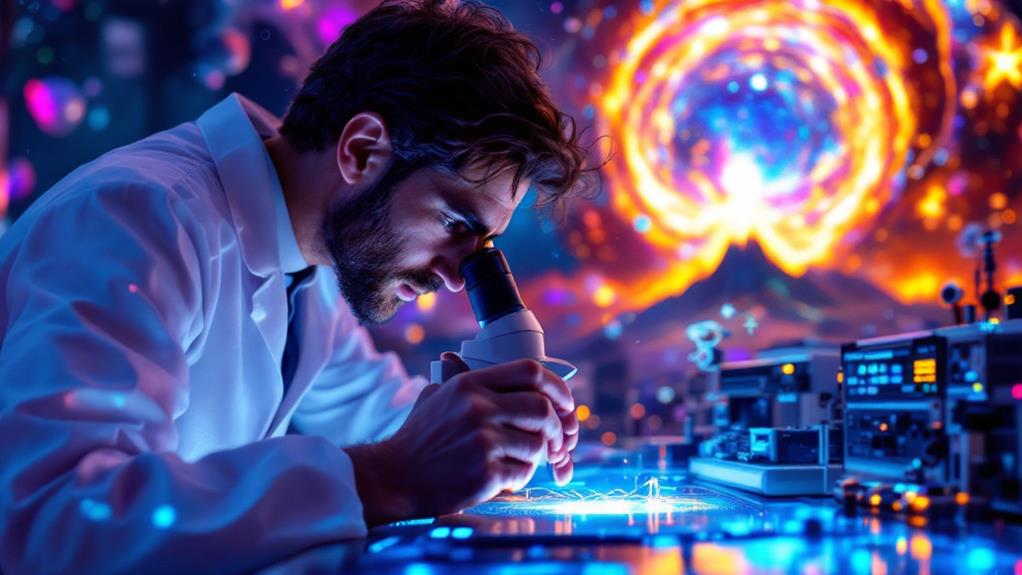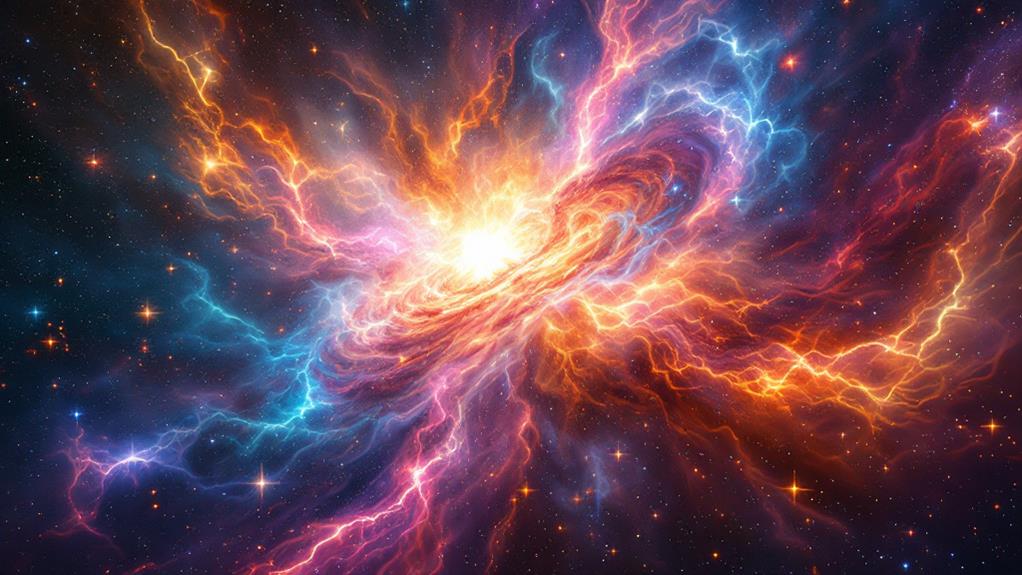Fascinating Facts About the Large Hadron Collider: Exploring Particle Physics
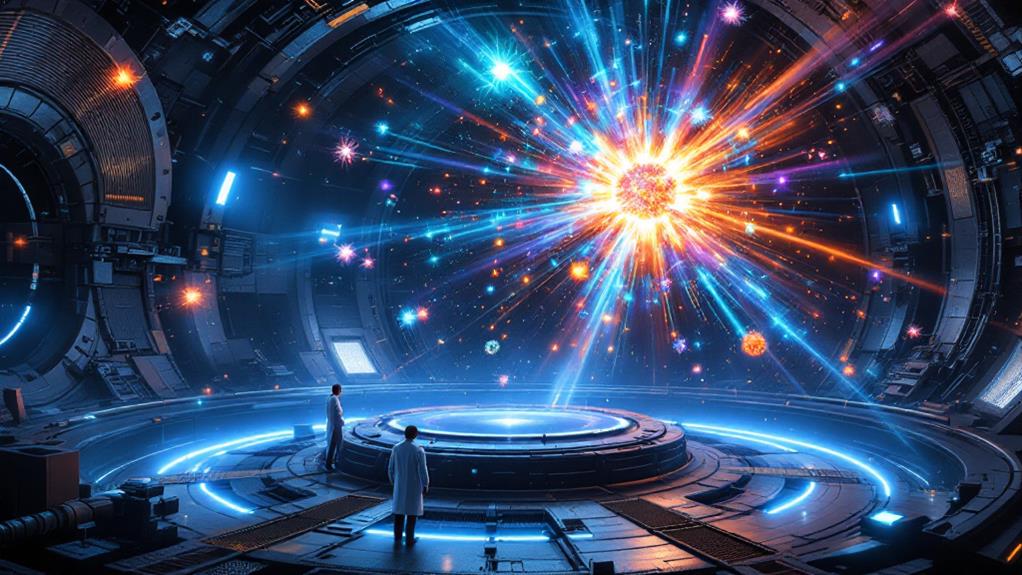
Did you know that the Large Hadron Collider (LHC) is home to the coldest place on Earth? It's colder than outer space at -271.3°C, thanks to its superconducting magnets. These magnets guide particle beams to collide at mind-boggling energies, generating temperatures 100,000 times hotter than the sun's core. The LHC produces a staggering 90 petabytes of data annually, analyzed by a global network of computers. It's also where the elusive Higgs boson was unearthed in 2012, confirming a fundamental theory in particle physics. The LHC's fascinating world of extreme temperatures, massive data, and pioneering findings is just the tip of the iceberg.
Colder Than Outer Space
In the heart of particle physics laboratories, temperatures plummet to extremes that would make even the coldest reaches of space seem balmy. You might be surprised to learn that the Large Hadron Collider (LHC) at CERN is actually the coolest location on Earth, surpassing the frigid temperatures of outer space.
The LHC's superconducting magnets operate at a staggering -271.3°C (1.9 Kelvin), which is colder than the average temperature of the universe at -270.45°C (2.7 Kelvin). This makes the LHC the coldest environment in our solar system, and possibly beyond.
To achieve these ultra-low temperatures, scientists use liquid helium to cool the magnets. This extreme cold is necessary for the superconducting magnets to function efficiently, guiding particle beams with precision.
The stark contrast between the LHC's frigid interior and the scorching temperatures generated during particle collisions is mind-boggling. While the magnets maintain their sub-zero environment, the energy released in collisions can momentarily create temperatures 100,000 times hotter than the sun's core.
Superconducting Magnets
Superconducting magnets are the unsung heroes of particle physics experiments. These powerful devices play a fundamental role in steering and focusing particle beams within the Large Hadron Collider (LHC). You'll find 1,232 of these magnets in the LHC, each measuring 15 meters in length and weighing around 35 tons.
What makes these magnets special is their ability to conduct electricity with zero resistance when cooled to extremely low temperatures. The LHC's magnets operate at a chilly -271.3°C (1.9 K), colder than outer space. This temperature is maintained through an advanced magnet cryogenics system that uses liquid helium.
The superconducting state allows these magnets to generate incredibly strong magnetic fields, up to 8.33 tesla, which is indispensable for guiding particles close to the speed of light. However, this state is delicate. If a magnet warms up suddenly, it can "quench," losing its superconductivity. To prevent damage, the LHC employs a sophisticated quench protection system that quickly dissipates the stored energy if a quench occurs, ensuring the safety of these essential components in particle physics research.
Particle Beam Collisions
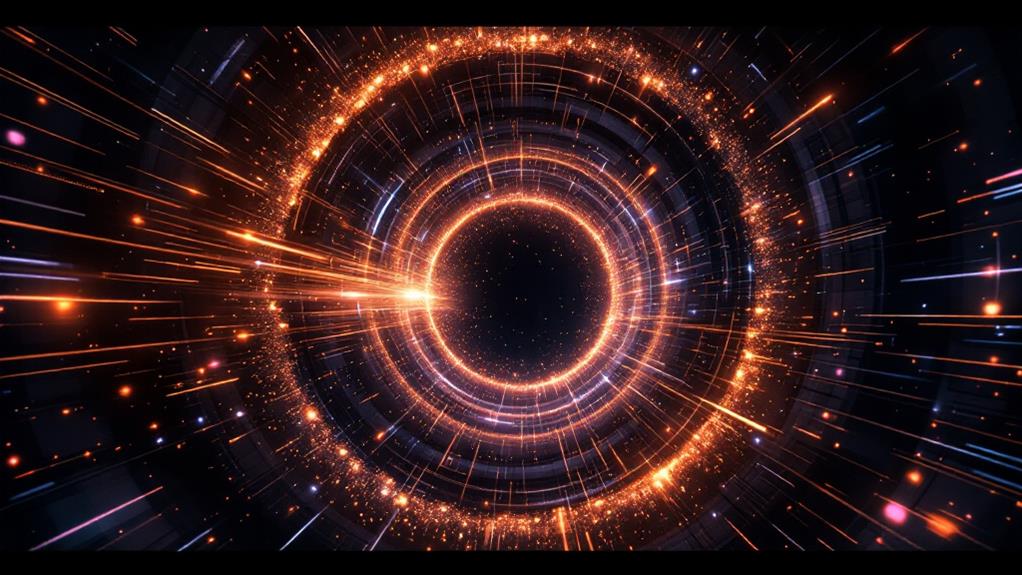
Particle beams hurtle towards each other at nearly the speed of light inside the Large Hadron Collider. As they collide, they create conditions similar to those just after the Big Bang. These high-energy collisions allow scientists to study the fundamental building blocks of matter and the forces that govern them.
The LHC accelerates protons or heavy ions in opposite directions, increasing their beam energy to unparalleled levels. When the beams intersect at designated collision points, particles smash together with immense force. These collisions produce a spray of subatomic particles and energy, which scientists analyze using sophisticated particle detection systems.
You'll find that particle detectors surrounding the collision points are indispensable for observing and measuring the products of these interactions. These detectors capture data on the paths, energies, and types of particles created in each collision. By studying millions of collisions, researchers can identify rare events and potentially uncover new particles or phenomena.
The higher the beam energy, the more likely it is to produce massive, short-lived particles that existed in the early universe. This allows you to peer into the fundamental nature of reality and unravel the secrets of particle physics.
Massive Data Generation
The LHC's experiments generate a staggering amount of data. When particle beams collide at near-light speeds, detectors capture millions of events per second. These events produce raw data at an astonishing rate of about 1 petabyte per second. To put this in perspective, you'd need over 20 million Blu-ray discs to store just one second of the LHC's raw data output.
However, not all this data is stored. Advanced trigger systems filter out less interesting events, reducing the data to a more manageable 1 gigabyte per second. Even with this reduction, the LHC produces around 90 petabytes of data annually, equivalent to filling a stack of CDs 20 km high.
The massive data generation leads to enormous data processing requirements. CERN employs a worldwide LHC Computing Grid, connecting thousands of computers across the globe to analyze this vast dataset. This distributed computing approach helps manage the colossal workload and energy consumption associated with processing such immense quantities of information. Scientists can then access and study this processed data to make remarkable revelations in particle physics.
International Collaboration

Analyzing the vast amounts of data generated by the LHC isn't a task for any single nation or institution. The LHC's success relies heavily on international collaboration, embodying the spirit of scientific diplomacy. Researchers from over 100 countries work together, pooling their skills and resources to explore the boundaries of particle physics.
Global partnerships form the backbone of the LHC's operations. You'll find scientists, engineers, and technicians from diverse backgrounds working side by side, united by their passion for investigation. This collaborative effort extends beyond the laboratory, with universities and research institutions worldwide contributing to data analysis and theoretical interpretations.
The international nature of the LHC project nurtures:
- Cross-cultural scientific exchange
- Shared funding and resource allocation
- Global talent recruitment and retention
- Diplomatic ties through scientific cooperation
- Worldwide dissemination of knowledge
These collaborations aren't just about sharing workload; they're about bringing together the brightest minds from around the globe. By leveraging diverse viewpoints and expertise, the LHC project accelerates scientific progress and promotes a culture of openness and cooperation in the scientific community. This model of international collaboration serves as an inspiring example for addressing other global challenges.
Higgs Boson Discovery
How did the scientific world react when the elusive Higgs boson was finally unearthed? The announcement on July 4, 2012, sent shockwaves through the physics community. After decades of searching, the Large Hadron Collider (LHC) had detected this exotic particle, confirming the Standard Model of particle physics.
You might wonder why the Higgs boson is so important. It's the key to understanding how particles acquire mass through quantum field interactions. The discovery validated Peter Higgs' theory from the 1960s and completed the Standard Model puzzle.
The LHC's exceptional feat involved smashing protons together at nearly the speed of light. Scientists sifted through vast amounts of data to identify the Higgs boson's signature decay patterns. This breakthrough required cutting-edge technology and innovative data analysis techniques.
The Higgs boson discovery has far-reaching implications for our understanding of the universe. It opens doors to exploring dark matter, supersymmetry, and other fundamental questions in physics. As you delve deeper into particle physics, you'll find that the Higgs boson is just the beginning of a groundbreaking era of scientific exploration.
Future Upgrades and Experiments
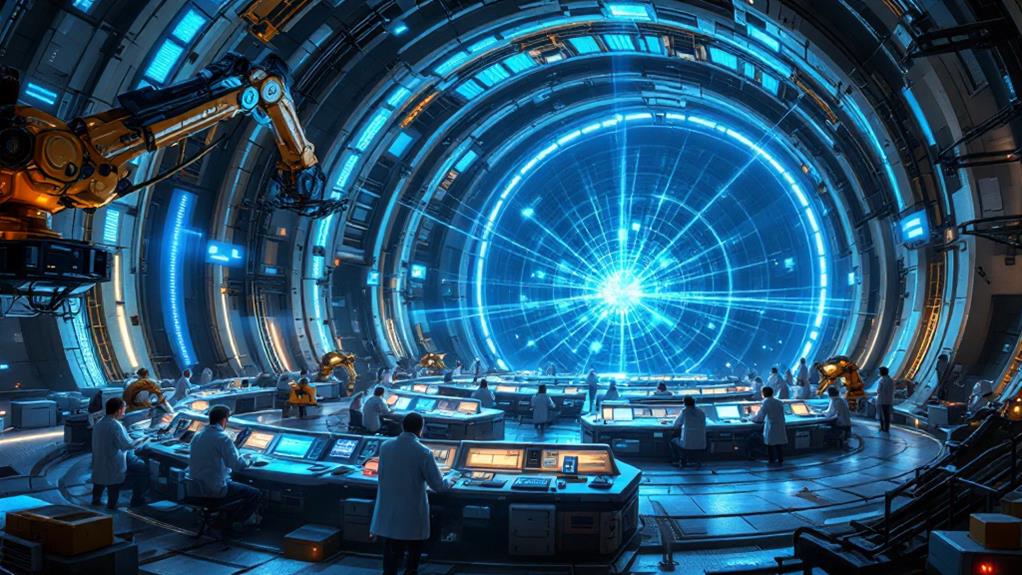
Three major upgrades are planned for the Large Hadron Collider in the coming years. These enhancements aim to extend the boundaries of particle physics even further. The first upgrade, known as the High-Luminosity LHC, will increase the number of particle collisions, allowing for more precise measurements and potential discoveries.
The particle beam upgrade will amplify the energy of the proton beams, enabling scientists to investigate higher energy regimes. This could lead to the detection of new particles or phenomena that were previously out of reach.
Experimental future plans include:
- Installation of new, more sensitive detectors
- Implementation of advanced data processing systems
- Development of innovative particle tracking technologies
- Construction of additional experimental halls
- Integration of machine learning algorithms for data analysis
These upgrades will significantly enhance the LHC's capabilities, potentially revealing mysteries surrounding dark matter, supersymmetry, and extra dimensions. You'll witness a transformative era of particle physics research, with experiments designed to probe the fundamental nature of our universe. As the LHC evolves, it'll continue to be at the forefront of scientific discovery, advancing the boundaries of human knowledge and understanding.

